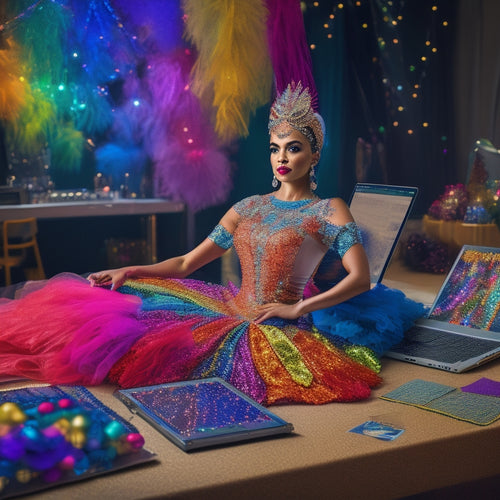
Discover the Rhythm: Dive Into Dance World
Share
Dance is a dynamic fusion of cultural heritage, creative expression, and physical movement, encompassing diverse styles and genres. It offers a wealth of benefits, including physical, emotional, and social advantages, such as improved fitness, mental wellness, and social connections. Across ages and stages, dance transcends cultural and ability boundaries, serving as a platform for self-expression, well-being, and connections. As a lifestyle, dance requires commitment and dedication, leading to personal growth and transformative self-discovery. As we explore the rhythms and movements of the dance world, the possibilities for creative expression, wellness, and growth unfold, inviting us to step further into this vibrant and inclusive world.
Key Takeaways
• Dance encompasses a rich cultural heritage and diverse stylistic expressions, with unique characteristics, techniques, and historical contexts.
• Dancing offers numerous benefits, including physical, emotional, and social advantages, as well as mental wellness and stress reduction.
• Dance is a universal language that transcends age, culture, and ability, serving as a platform for self-expression, well-being, and connections.
• Embracing dance as a lifestyle requires commitment to regular practice, dedication to perfecting techniques, and a passion for creative expression.
• The world of dance offers opportunities for personal growth, therapeutic benefits, and career paths in performing, teaching, and choreographing.
Explore Dance Styles and Genres
With its rich cultural heritage and diverse stylistic expressions, the world of dance offers a vast array of genres and styles, each with its unique characteristics, techniques, and historical contexts, waiting to be explored and mastered.
From the elegance of ballet to the sensuality of belly dance, each style is shaped by its cultural influences and historical roots. The evolution of dance is a demonstration of its adaptability, with modern trends infusing traditional techniques with contemporary flair.
Unique dance styles, such as jazz and ballroom, showcase the fusion of different cultural influences, resulting in a rich tapestry of expressions. As we immerse ourselves in the world of dance, we uncover a space where creativity, cultural heritage, and self-expression converge.
Discover the Benefits of Dance
As we explore the world of dance, it becomes increasingly evident that the benefits of dance extend far beyond the domain of mere aesthetics, encompassing a wide range of physical, emotional, and social advantages that can positively impact one's overall well-being.
In addition, through dance, individuals can cultivate mental wellness by reducing stress and anxiety, while also improving physical fitness through increased coordination and flexibility.
Moreover, dance provides opportunities for social connections, fostering a sense of community and belonging among dancers.
Additionally, dance serves as a powerful medium for self-expression, allowing individuals to convey emotions and tell stories through movement.
Dance for Every Age and Stage
Across the lifespan, dance offers a universal language that transcends age, cultural background, and ability, providing a unique platform for individuals of all ages and stages to express themselves, cultivate physical and emotional well-being, and forge meaningful connections with others. Dance for seniors, in particular, has been shown to have numerous benefits, including improved mobility, balance, and cognitive function. Additionally, dance therapy has been widely recognized as an effective tool in promoting mental health and rehabilitation.
Embracing Dance as a Lifestyle
Embracing dance as a lifestyle requires a deep commitment to regular practice, dedication to perfecting techniques, and a passion for creative expression, ultimately leading to a transformative journey of self-discovery and personal growth.
As dancers explore further into their craft, they may discover the therapeutic benefits of dance, using dance therapy to heal and cope with emotional challenges.
For those who aspire to make a living through dance, a dance career can be a fulfilling path, offering opportunities to perform, teach, or choreograph.
Frequently Asked Questions
What Is the Best Way to Overcome Stage Fright While Dancing?
To overcome stage fright while dancing, incorporate mindfulness techniques, such as meditation and visualization, and practice breathing exercises to calm the nervous system, allowing for a more centered and confident performance.
How Do I Choose the Right Dance Style for My Fitness Goals?
When selecting a dance style for fitness goals, consider your dance personality: do you prefer high-energy intensity or low-impact flexibility? Align your fitness objectives with a style that complements your personality, ensuring a harmonious and effective workout experience.
Can I Learn to Dance if I Have a Physical Disability?
Individuals with physical disabilities can learn to dance by adapting techniques to their abilities, utilizing accessible choreography, and modifying movements to accommodate physical limitations, fostering inclusivity and creative expression.
What Is the Ideal Frequency for Practicing Dance to See Progress?
To see progress in dance, aim for consistent practice, ideally 2-3 times a week, with progressive overload, gradually increasing intensity and difficulty, to challenge your body and foster improvement in technique and overall performance.
How Can I Balance Dance Practice With Other Responsibilities?
To balance dance practice with other responsibilities, implement effective time management and prioritization strategies, allocating specific time slots for dance practice, and adjusting schedules as needed to guarantee a harmonious balance between responsibilities and personal pursuits.
Related Posts
-

3 Essential Tools for Dance Makeup Artists Online
As a dance makeup artist, you already possess the skills to create stunning looks, and with the right digital tools, ...
-

Design Stunning Dance Costumes With Online Tutorials
With online tutorials, you're just a click away from accessing stunning dance costumes that mesmerize the audience. D...
-

Unlocking Showmanship Secrets: Pole Dance Competition Mastery
You're about to discover the secrets to pole dance competition mastery, where a cohesive narrative, not just tricks, ...


